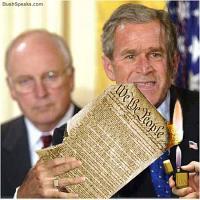
Frank Rich does a truly superb job of reminding us to keep our eyes on the prize.
It’s Bush-Cheney, Not Rove-Libby
By FRANK RICH
THERE hasn’t been anything like it since Martha Stewart fended off questions about her stock-trading scandal by manically chopping cabbage on “The Early Show” on CBS. Last week the setting was “Today” on NBC, where the image of President Bush manically hammering nails at a Habitat for Humanity construction site on the Gulf Coast was juggled with the sight of him trying to duck Matt Lauer’s questions about Karl Rove.
As with Ms. Stewart, Mr. Bush’s paroxysm of panic was must-see TV. “The president was a blur of blinks, taps, jiggles, pivots and shifts,” Dana Milbank wrote in The Washington Post. Asked repeatedly about Mr. Rove’s serial appearances before a Washington grand jury, the jittery Mr. Bush, for once bereft of a script, improvised a passable impersonation of Norman Bates being quizzed by the detective in “Psycho.” Like Norman and Ms. Stewart, he stonewalled.
That stonewall may start to crumble in a Washington courtroom this week or next. In a sense it already has. Now, as always, what matters most in this case is not whether Mr. Rove and Lewis Libby engaged in a petty conspiracy to seek revenge on a whistle-blower, Joseph Wilson, by unmasking his wife, Valerie, a covert C.I.A. officer. What makes Patrick Fitzgerald’s investigation compelling, whatever its outcome, is its illumination of a conspiracy that was not at all petty: the one that took us on false premises into a reckless and wasteful war in Iraq. That conspiracy was instigated by Mr. Rove’s boss, George W. Bush, and Mr. Libby’s boss, Dick Cheney.
Mr. Wilson and his wife were trashed to protect that larger plot. Because the personnel in both stories overlap, the bits and pieces we’ve learned about the leak inquiry over the past two years have gradually helped fill in the über-narrative about the war. Last week was no exception. Deep in a Wall Street Journal account of Judy Miller’s grand jury appearance was this crucial sentence: “Lawyers familiar with the investigation believe that at least part of the outcome likely hangs on the inner workings of what has been dubbed the White House Iraq Group.”
Very little has been written about the White House Iraq Group, or WHIG. Its inception in August 2002, seven months before the invasion of Iraq, was never announced. Only much later would a newspaper article or two mention it in passing, reporting that it had been set up by Andrew Card, the White House chief of staff. Its eight members included Mr. Rove, Mr. Libby, Condoleezza Rice and the spinmeisters Karen Hughes and Mary Matalin. Its mission: to market a war in Iraq.
Of course, the official Bush history would have us believe that in August 2002 no decision had yet been made on that war. Dates bracketing the formation of WHIG tell us otherwise. On July 23, 2002 - a week or two before WHIG first convened in earnest - a British official told his peers, as recorded in the now famous Downing Street memo, that the Bush administration was ensuring that “the intelligence and facts” about Iraq’s W.M.D.’s “were being fixed around the policy” of going to war. And on Sept. 6, 2002 - just a few weeks after WHIG first convened - Mr. Card alluded to his group’s existence by telling Elisabeth Bumiller of The New York Times that there was a plan afoot to sell a war against Saddam Hussein: “From a marketing point of view, you don’t introduce new products in August.”
The official introduction of that product began just two days later. On the Sunday talk shows of Sept. 8, Ms. Rice warned that “we don’t want the smoking gun to be a mushroom cloud,” and Mr. Cheney, who had already started the nuclear doomsday drumbeat in three August speeches, described Saddam as “actively and aggressively seeking to acquire nuclear weapons.” The vice president cited as evidence a front-page article, later debunked, about supposedly nefarious aluminum tubes co-written by Judy Miller in that morning’s Times. The national security journalist James Bamford, in “A Pretext for War,” writes that the article was all too perfectly timed to facilitate “exactly the sort of propaganda coup that the White House Iraq Group had been set up to stage-manage.”
The administration’s doomsday imagery was ratcheted up from that day on. As Barton Gellman and Walter Pincus of The Washington Post would determine in the first account of WHIG a full year later, the administration’s “escalation of nuclear rhetoric” could be traced to the group’s formation. Along with mushroom clouds, uranium was another favored image, the Post report noted, “because anyone could see its connection to an atomic bomb.” It appeared in a Bush radio address the weekend after the Rice-Cheney Sunday show blitz and would reach its apotheosis with the infamously fictional 16 words about “uranium from Africa” in Mr. Bush’s January 2003 State of the Union address on the eve of war.
Read the whole thing....
Frank Rich Bush Cheney Karl Rove CIA leak Plamegate Rove Fitzgerald Valerie Plame Judith Miller Bush Iraq War